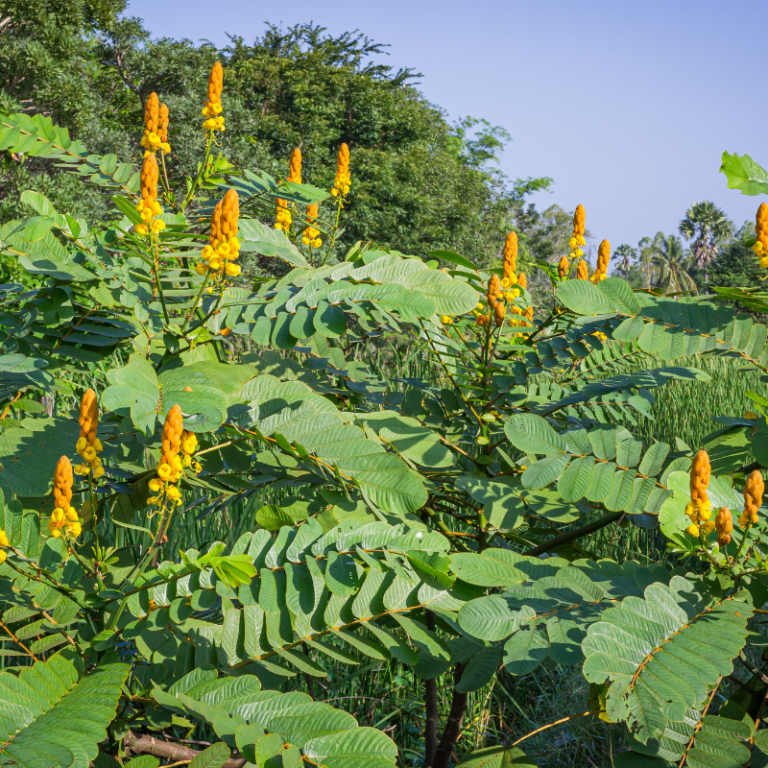Senna alata, often referred to as Candle Bush, Emperor’s Candlestick, and Candelabra Bush, is widely known for its striking yellow, candle-like flowers. This tropical plant, valued for both its medicinal benefits and aesthetic appeal, has roots in traditional medicine and modern landscaping alike. The Senna alata benefits make it a popular choice for those interested in sustainable gardening and natural remedies.
Classification and Taxonomy of Senna alata
Belonging to the Caesalpinioideae subfamily within the legume family, Senna alata is a visually captivating shrub or small tree. The plant’s pinnate leaves and tall, golden-yellow flower spikes make it an eye-catching addition to any garden. Known for its resilience, this tropical shrub reaches impressive heights when provided with the right conditions.
Physical Characteristics of Senna alata (Candle Bush)
Growing between 12-30 feet in its native habitats, Senna alata has a lush, dense foliage structure with leaves up to 75 cm in length. The plant’s signature candle-like flower spikes bloom sequentially from the bottom up, lending it the nickname Candle Bush. Its vibrant blooms attract pollinators, promoting biodiversity in tropical gardens.
Habitat and Distribution
Senna alata is native to the tropical and humid regions of Central and South America. However, due to its adaptability, it has spread across various continents. The plant thrives in different conditions, from drought-prone areas to waterlogged soils. This adaptability has made it a popular choice for landscaping in warm climates worldwide.
Interestingly, in certain regions, Senna alata has become invasive, outcompeting local plants and requiring careful management. For more detailed information on growing Senna alata in tropical climates, you can refer to the University of Florida’s guide on Candlebrush care and characteristics.
Climate and Soil Requirements for Optimal Senna alata Growth
This hardy plant thrives in full sunlight and warm temperatures, making it ideal for tropical climates. While it prefers fertile, well-drained soil, Senna alata is tolerant of poor soil conditions and moderate drought. For gardeners, the Senna alata benefits extend to its ease of cultivation in challenging conditions.
Propagation Methods
- Seeds: Propagation by seed is common and straightforward. Soaking seeds before planting can speed up germination.
- Cuttings: Rooting cuttings from a mature plant is also effective, especially in consistently warm conditions.
Maintenance Tips
- Prune regularly to maintain a manageable size and promote bushier growth.
- Fertilize during the growing season to support flowering.
- Monitor for pests, though Senna alata is generally pest-resistant.
Medicinal Uses and Benefits
Senna alata has been used for centuries in traditional medicine, especially for skin conditions. Key Senna alata benefits include:
- Skin Health: Its antimicrobial properties are beneficial for treating skin infections, blisters, and various inflammatory skin conditions.
- Respiratory and Digestive Health: In folk medicine, it has been employed to address respiratory and digestive issues.
- Antimicrobial Properties: Rich in anthraquinones and flavonoids, the plant shows promise in ongoing studies for its natural antimicrobial benefits.
If you’re interested in other natural remedies, check out guides on using everyday items for health, such as honey for wound healing.
Other Uses of Senna alata
Beyond its medicinal properties, Senna alata serves as an attractive ornamental plant. Its bright blooms and tall structure add visual interest to gardens, while also attracting bees, butterflies, and other pollinators. Additionally, the plant’s robust root system makes it useful in erosion control, helping to stabilize soil in vulnerable areas.
Environmental and Ecological Impacts
Invasiveness in Non-Native Regions
In areas outside its native habitat, Senna alata can become invasive, overshadowing local flora and reducing biodiversity. This adaptability requires regular maintenance to prevent unchecked growth.
Positive Ecological Contributions
Conversely, when managed correctly, Senna alata can contribute positively to the ecosystem by stabilizing soil and providing habitats for pollinators. Its versatility makes it an asset in reforestation and ecological restoration projects.
Phytochemistry of Senna alata
The therapeutic effects of Senna alata are largely due to its rich phytochemical composition, which includes:
- Anthraquinones: Known for antimicrobial effects, useful in treating infections.
- Flavonoids: With antioxidant properties, they contribute to overall health and skin protection.
- Tannins: These compounds aid in inflammation reduction, making the plant effective for skin treatments.
The Senna alata benefits from these phytochemicals continue to attract scientific interest, with potential applications in skincare and healthcare.
Toxicity and Safety Considerations
While Senna alata is generally safe for external use, caution is advised in some cases:
- Dosage: Overuse may lead to toxicity, especially due to anthraquinones. It’s best to consult a professional for safe usage.
- Precautions: Pregnant individuals and those with skin sensitivities should consult a healthcare provider before use.
Cultural Significance and Historical Background
Throughout history, Senna alata has held significance in traditional medicine and cultural practices. Used in herbal remedies across various tropical regions, it remains an integral part of folk medicine.
Frequently Asked Questions (FAQs)
- What are the medicinal uses of Senna alata?
It’s primarily used for skin issues, infections, and as an antimicrobial agent. - Can Senna alata be grown indoors?
While possible, it requires ample light and space, making it more suitable for outdoor cultivation. - How does Senna alata benefit the skin?
Its antimicrobial and anti-inflammatory properties make it effective for treating skin infections and irritations. - Is Senna alata toxic to pets?
Ingesting large quantities may be harmful to pets. It’s best to keep pets from consuming the plant. - What are the ideal growing conditions for Senna alata?
Warm temperatures, full sunlight, and well-drained soil are ideal.
Conclusion
The Senna alata benefits span medicinal, ornamental, and ecological uses. Whether cultivated for its therapeutic properties or as a vibrant addition to the garden, Senna alata offers a wide range of benefits. With a rich history and broad utility, Senna alata is an exceptional plant that brings together natural beauty and health benefits in a sustainable way.
